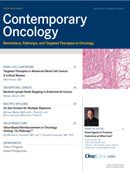Publication
Article
Novel Agents in Practice: Outcomes at What Cost?
Author(s):
The real question is how will we best use our continually evolving armamentarium of treatments to deliver the best outcomes while optimizing the cost of care for our patients.
Andre Goy, MD, MS
Editor-in-Chief Contemporary Oncology Chief, Lymphoma Division, Chairman John Theurer Cancer Center at Hackensack University Medical Center
At first blush, the articles in this issue of Contemporary Oncology may appear to be unrelated; however, upon closer inspection, we see how they illustrate the challenging but fascinating changes that are currently taking place in oncology. This issue of Contemporary Oncology covers a diverse landscape: the implementation of sentinel node mapping in endometrial cancer; emerging questions on how we should combine very promising small molecules (ie, together / sequentially / alternating) in renal cancer or multiple myeloma; and an exploration of how these clinical decisions fit into the ongoing economic forces in how we manage patients with cancer.
Individually, each of these articles highlights the best benefit for a subpopulation of patients at a given stage of their disease (eg, in the relapse setting as part of a phase II trial). The common thread throughout these articles is how emerging, novel therapies fit into existing treatment paradigms. For example, will combinations of novel therapies affect the use or timing of high-dose therapy and stem cell transplantation in multiple myeloma? Collectively, the real question these articles pose is how will we best use our continually evolving armamentarium of treatments to deliver the best outcomes while optimizing the cost of care for our patients.
Given the unsustainable cost progression in oncology, and medicine as a whole, the adjustments required to meet these challenges provide a great opportunity to develop “smarter” algorithms that take into consideration all of our available therapies, as well as our growing awareness of the diversity of cancer patients. This implies that we need to do a better job of molecularly stratifying patients (ie, integration of molecular diagnostics) and of defining biomarker-driven pathways for both conventional therapies (ex vivo cytotoxics) and novel therapies—thus basing fewer treatment decisions solely on empiric choices.
Providing a better rationale for our decisions would not only help reduce costs in the routine practice of oncology, but this additional level of transparency may also have the added benefit of improving clinical trials enrollment, which remains a weak link in our current approach.









